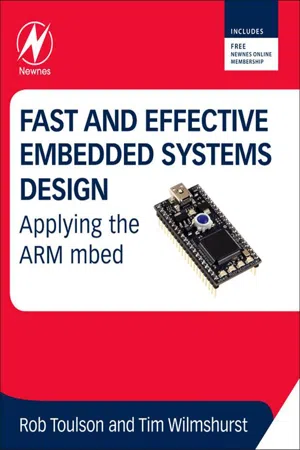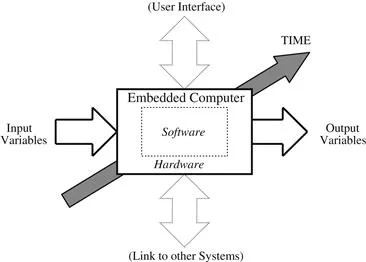
eBook - ePub
Fast and Effective Embedded Systems Design
Applying the ARM mbed
- 400 pages
- English
- ePUB (mobile friendly)
- Available on iOS & Android
eBook - ePub
About this book
Fast and Effective Embedded Systems Design is a fast-moving introduction to embedded system design, applying the innovative ARM mbed and its web-based development environment. Each chapter introduces a major topic in embedded systems, and proceeds as a series of practical experiments, adopting a "learning through doing" strategy. Minimal background knowledge is needed. C/C++ programming is applied, with a step-by-step approach which allows the novice to get coding quickly. Once the basics are covered, the book progresses to some "hot" embedded issues – intelligent instrumentation, networked systems, closed loop control, and digital signal processing.
Written by two experts in the field, this book reflects on the experimental results, develops and matches theory to practice, evaluates the strengths and weaknesses of the technology or technique introduced, and considers applications and the wider context. Numerous exercises and end of chapter questions are included.
- A hands-on introduction to the field of embedded systems, with a focus on fast prototyping
- Key embedded system concepts covered through simple and effective experimentation
- Amazing breadth of coverage, from simple digital i/o, to advanced networking and control
- Applies the most accessible tools available in the embedded world
- Supported by mbed and book web sites, containing FAQs and all code examples
- Deep insights into ARM technology, and aspects of microcontroller architecture
- Instructor support available, including power point slides, and solutions to questions and exercises
Frequently asked questions
Yes, you can cancel anytime from the Subscription tab in your account settings on the Perlego website. Your subscription will stay active until the end of your current billing period. Learn how to cancel your subscription.
No, books cannot be downloaded as external files, such as PDFs, for use outside of Perlego. However, you can download books within the Perlego app for offline reading on mobile or tablet. Learn more here.
Perlego offers two plans: Essential and Complete
- Essential is ideal for learners and professionals who enjoy exploring a wide range of subjects. Access the Essential Library with 800,000+ trusted titles and best-sellers across business, personal growth, and the humanities. Includes unlimited reading time and Standard Read Aloud voice.
- Complete: Perfect for advanced learners and researchers needing full, unrestricted access. Unlock 1.4M+ books across hundreds of subjects, including academic and specialized titles. The Complete Plan also includes advanced features like Premium Read Aloud and Research Assistant.
We are an online textbook subscription service, where you can get access to an entire online library for less than the price of a single book per month. With over 1 million books across 1000+ topics, we’ve got you covered! Learn more here.
Look out for the read-aloud symbol on your next book to see if you can listen to it. The read-aloud tool reads text aloud for you, highlighting the text as it is being read. You can pause it, speed it up and slow it down. Learn more here.
Yes! You can use the Perlego app on both iOS or Android devices to read anytime, anywhere — even offline. Perfect for commutes or when you’re on the go.
Please note we cannot support devices running on iOS 13 and Android 7 or earlier. Learn more about using the app.
Please note we cannot support devices running on iOS 13 and Android 7 or earlier. Learn more about using the app.
Yes, you can access Fast and Effective Embedded Systems Design by Tim Wilmshurst,Rob Toulson in PDF and/or ePUB format, as well as other popular books in Design & Hardware. We have over one million books available in our catalogue for you to explore.
Information
PART I
Essentials of Embedded Systems, using the mbed
Chapter 1 Embedded Systems, Microcontrollers and ARM
Chapter 2 Introducing the mbed
Chapter 3 Digital Input and Output
Chapter 4 Analog Output
Chapter 5 Analog Input
Chapter 6 Further Programming Techniques
Chapter 7 Starting with Serial Communication
Chapter 8 Liquid Crystal Displays
Chapter 9 Interrupts, Timers and Tasks
Chapter 10 Memory and Data Management
Chapter 1
Embedded Systems, Microcontrollers and ARM
Chapter outline
1.1 Introducing Embedded Systems
1.1.1 What is an Embedded System?
1.1.2 An Example Embedded System
1.2 Microprocessors and Microcontrollers
1.2.1 Some Computer Essentials
1.2.2 The Microcontroller
1.3 Development Processes in Embedded Systems
1.3.1 Programming Languages: What is so Special about C/C++?
1.3.2 The Development Cycle
1.4 The World of ARM
1.4.1 A Little History
1.4.2 Some Technical Detail: What does this RISC Word Mean?
1.4.3 The Cortex Core
Chapter Review
Quiz
References
1.1 Introducing Embedded Systems
1.1.1 What is an Embedded System?
We are all familiar with the idea of a desktop or laptop computer, and the amazing processing that they can do. These computers are general purpose; we can get them to do different things at different times, depending on the application or program we run on them. At the very heart of such computers is a microprocessor, a tiny and fantastically complicated electronic circuit which contains the core features of a computer. All of this is fabricated on a single slice of silicon, called an integrated circuit (IC). Some people, particularly those who are not engineers themselves, call these circuits microchips, or just chips.
What is less familiar to many people is the idea that instead of putting a microprocessor in a general-purpose computer, it can also be placed inside a product which has nothing to do with computing, like a washing machine, toaster or camera. The microprocessor is then customized to control that product. The computer is there, inside the product; but it cannot be seen, and the user probably does not even know it is there. Moreover, those add-ons that are normally associated with a computer, like keyboard, screen or mouse, are nowhere to be seen. Such products are called embedded systems, because the computer that controls them is embedded right inside. Because they tend to focus on control, in many cases the microprocessors used in embedded systems develop different characteristics from the ones used in more general-purpose machines. They are called microcontrollers. Although much less visible than their microprocessor cousins, microcontrollers sell in far greater volume and their impact has been enormous. To the electronic and system designer they offer huge opportunities.
Embedded systems come in many forms and guises. They are extremely common in the home, the motor vehicle and the workplace. Most modern domestic appliances, like washing machines, dishwashers, ovens, central heating and burglar alarms, are embedded systems. The motor car is full of them, in engine management, security (for example, locking and anti-theft devices), air-conditioning, brakes, radio, and so on. They are found across industry and commerce, in machine control, factory automation, robotics, electronic commerce and office equipment. The list has almost no end, and it continues to grow.
Figure 1.1 expresses the embedded system as a simple block diagram. There is a set of inputs from the controlled system. The embedded computer, usually a microcontroller, runs a program dedicated to this application, permanently stored in its memory. Unlike the general-purpose desktop computer, which runs many programs, this is the only program it ever runs. Based on information supplied from the inputs, the microcontroller computes certain outputs, which are connected to things like actuators within the system. The actual electronic circuit, along with any electromechanical components, is often called the hardware; the program running on it is often called the software. Aside from all of this, there may also be interaction with a user, for example via keypad and display, and there may be interaction with other subsystems elsewhere, although neither of these is essential to the general concept. One other variable will affect all that we do in embedded systems, and this is time, represented as a dominating arrow which cuts across the figure. We will need to be able to measure time, make things happen at precisely predetermined times, generate data streams or other signals with a strong time dependence, and respond to unexpected things in a timely fashion.

Figure 1.1: The embedded system
This chapter introduces or reviews many concepts relating to computers, microprocessors, microcontrollers and embedded systems. It does this in overview form, to give a platform for further learning. We return to most concepts in later chapters, building on them and adding detail. More details can also be found in Reference 1.1.
1.1.2 An Exam...
Table of contents
- Cover image
- Title page
- Table of Contents
- Please visit the Companion
- Copyright
- Introduction
- Acknowledgments
- PART I: Essentials of Embedded Systems, using the mbed
- PART II: Moving to Advanced and Specialist Applications
- APPENDIX A: Some Number Systems
- APPENDIX B: Some C Essentials
- APPENDIX C: mbed Technical Data
- APPENDIX D: Parts List
- APPENDIX E: The Tera Term Terminal Emulator
- Index